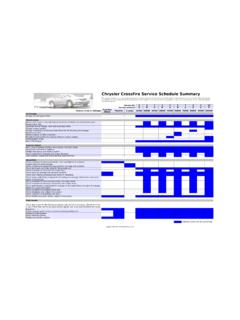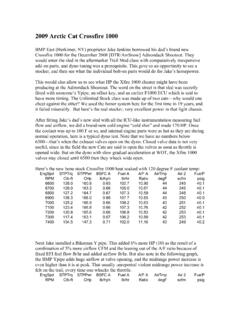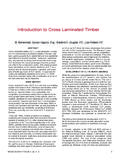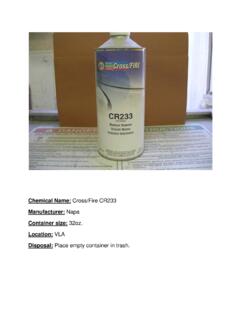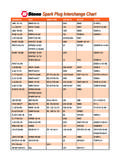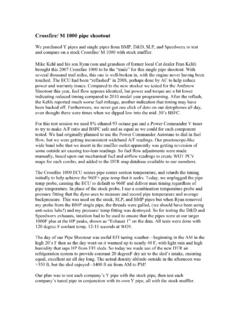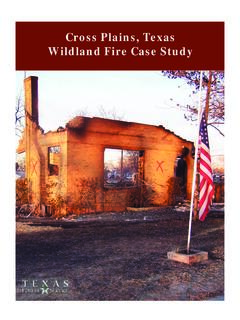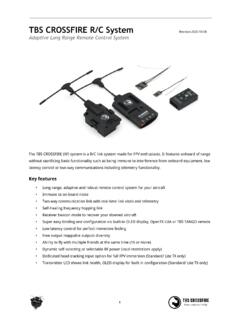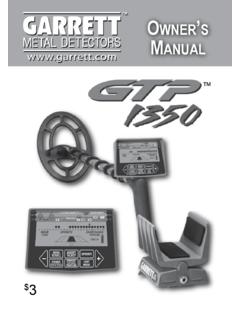Transcription of Automatic Sprinkler System Basics - Fire Suppression
1 Liberty Mutual systems are the most widely used and reliable Automatic source of fire protection available. National FireProtection Association (NFPA) statistics show that human error andsystem impairments significantly reduce the reliability of theseautomatic systems. Learning the basic components of your Sprinkler System and how it operates will help you effectivelyimplement human element programs, policies and procedures toensure its 13,The Standard for the Installation of Sprinkler Systems, defines a sprinklersystem as a combination of underground and overhead piping connected to anautomatic water supply and installed throughout a building. Sprinkler systems candetect fire , transmit an alarm and control or suppress a fire . In most systems, indi-vidual sprinklers are activated by the heat of a fire and discharge water where theycan effectively protect both the structure and its MANAGEMENT GUIDEA utomatic Sprinkler System Basicsfrom Liberty MutualPropertyTHE FOUR BASICCOMPONENTS OF ASPRINKLER SYSTEMS prinklers:Devices that automaticallydischarge water over a specified are two main types of sprinklers have a heat activatedelement made of either a glass bulb ora fusible metal link that bursts or meltsat a specified temperature.
2 Opensprinkers do not have this heat activat-ed element and will discharge water assoon as it is available to the sprinklersystem. Open systems require a sepa-rate fire detection System to release thewater into the System piping (Figure 1):Consists ofthe following pipes: System riser:A vertical supply pipelocated between the water supplyand feed mains. The riser usuallycontains a control valve to regu-late the water supply, a water-flowalarm device and a main :Supply water to thebranch lines:Supply water to piping:Underground watersupply piping that feeds the :Devices that control the flow ofwater through a pipe. Indicating valveshave components that show externallyFeed Main System Riser cross Main Branch LinesRiser NipplesSprinklers Figure Piping and Sprinklerswhether the valves are open or shut.
3 A common example is anoutside screw & yoke (OS&Y) control valve or a post indicatingvalve (PIV).TYPES OF Automatic Sprinkler SYSTEMST here are five basic Sprinkler System types. Each System hasdistinctive operating characteristics that should be addressedby the end Sprinkler System :The piping in a wet System is filled withpressurized water. Closed sprinklers open when activated byheat and immediately discharge :Wet Sprinkler systems are the most common type ofsystem. They should not be used in areas where the temperature may fall below 40 Sprinkler System :The piping in a dry System is filled withpressurized air or nitrogen, instead of water. Once enough heatis generated to activate one or more sprinklers, the air isreleased from the systemthrough the sprinklers.
4 At apredetermined pressure, adry pipe valve automaticallyopens and releases water tothe open sprinklers. There isa nominal delay betweenthe opening of the dry pipevalve and the water dis-charge from the sprinklers,as the air within the sprin-kler piping is :Dry systems are usedto protect areas subject to freezing, such as unheated ware-houses, loading docks and attic Sprinkler System :Similar to a dry System , the pipingin a preaction System does not contain water and may or maynot be filled with pressurized air. Water from the supply piping is held back by a preaction valve and is released to the systempiping when the fire detection System and/or sprinklers(depending on the type of preaction System ) are three types of preaction systems are listed interlock preaction System :Use:Single interlock preaction systems are used to protect high-value electronic equipment in areas such ascomputer interlock System :Use.
5 Double interlock preaction systems are used to protect freezers where the chance of accidental waterdischarge must be Mutual ( F)SprinklerTemperatureRating ( F)SprinklerFrame Color CodeGlass BulbColor Code100135 170 Uncolored or BlackOrange or Red150175 225 WhiteYellow or Green225250 300 BlueBlue300325 375 RedPurple375400 475 GreenBlack475500 575 OrangeBlack625650 OrangeBlackFigure RatingsPost indicator valve closedPost indicator valve openOutside screw and yokeClosed Sprinkler with a green glass bulb indicating atemperature rating of175 225 FNon-interlocked preaction System :Use:Non-interlocked preaction systems are used to protect unheated warehouses or small airplane System :Uses open sprinklers to deliver a large quantity of water over a specified area in a short period of deluge valve is activated by a fire detection System installedin the same area as the sprinklers.
6 When the deluge valveopens, water flows into the System and discharges from all theattached sprinklers in the :Deluge systems are used to protect flammable liquid storage, lumberyards, large airplane hangars andelectrical Sprinkler System :This is a wet System that containsan antifreeze solution in the piping. When the sprinklers areactivated, the antifreeze solution is discharged, followed bywater from the supply piping. The antifreeze helps prevent thesystem piping from :Antifreeze systems are used in Sprinkler DESIGN ANDTEMPERATURE RATINGSA utomatic Sprinkler systems are available in a variety ofdesigns to accommodate a diverse range of occupancies andstorage types. In occupancies where aesthetics are important,sprinklers can be hidden by a manufacturer installed decorativeplate.
7 These plates are designed to fall off first, allowing sprinklers to operate in the event of a can have special coatings and protective finishes applied by themanufacturer for decorative appeal orfor use in corrosive and other harshenvironments. However, sprinklers anddecorative plates should not be paintedor altered once received from the sprinklers have various temperature ratings and designs,based on normal air temperatures and hazardous elements within theiroccupancy. The metal frame or glassbulb of a Sprinkler can be color-codedto indicate its specific temperature rating. Refer to Figure 2 for a guide totemperature SIZE AND RESPONSE TIMEThe K-factor is the mathematical constant established by themanufacturer that relates the flow of water that can be expect-ed from a Sprinkler at a given pressure.
8 The K-factor increasesas the orifice size of the Sprinkler increases. The K-factor for astandard 1/2 inch Sprinkler is Refer to Figure 3 for other 13 states that larger K-factor sprinklers should be used to protect greater fire loads, since they are more effective insuppressing fires in more demanding Suppression fast response (ESFR) sprinklers are used toprotect various occupancies according to the UnderwritersLaboratory (UL) listing. The K-factor for the ESFR Sprinkler canrange from to This Sprinkler is designed to protectrack storage of various commodities and heights without theneed for in-rack caution when installing ESFR sprinklers because they cannot be obstructed by bottom chords, bridge strappings,electrical conduit, unit heaters or other building your Liberty Mutual Property loss prevention consultantif you plan to install an ESFR System .
9 He or she can helpassure you that the sprinklers are installed per NFPA standardsthrough a plan review process and an installation our Risk Management Guide,Specifications and ReviewProcessfor more Mutual Orifice SizesPercent ofNominal 251/2 501/2 751/2 1001/2 1403/4 or 1/2 2001/2 or 3/4 2503/4 Figure and Sprinkler Orifice Relationshipsmart &responsiveWhile following the procedures and information outlined in this guide may aid in avoiding problems associated with Sprinkler systems, they do not contemplate every potential for loss or damage. Therefore,every situation should be reviewed by the appropriate safety manager in an effort to take all steps and precautions to minimize Sprinkler System hazards.
10 No duty or undertaking is intended or assumed by Liberty Mutual by this publication as it is informational in purpose. Copyright 2007, Liberty Mutual. This brochure is for informational purposes Riverside RoadWeston, MA 02493 TEL: 781-891-0230 EMAIL: 10/07 For more Risk Management Guides, go Hurricane & Tropical StormCatastrophe Action Plan &ChecklistsPE1004 Minimizing Hot Work FiresPE1005 Human Element ProgramsPE1012 Wet Pipe SystemsPE1013 Dry Pipe Sprinkler SystemsPE1015 fire PumpsPE1021 Keeping Sprinklers in Service PE1022 Sprinkler Plan ReviewsPE1023 Transverse Flue Space PE1025 Flammable and CombustibleLiquids PE1026 Flood Exposures PE1027 Maintaining fire DoorsPE1028 Avoiding Sprinkler Damage for the Hospitality IndustryPE1029 Winter Threats PE1030 Protection for Large Dip Tanks PE1031 Idle Pallet Storage PE1032 HID LightingPE1033 Spiral CoolersPE1034 Ammonia RefrigerationPE1035 Specification and Review ProcessPE1036 Industrial Oil CookersPE1037 Freezer and Cooler HazardsPE1038 Minimizing
